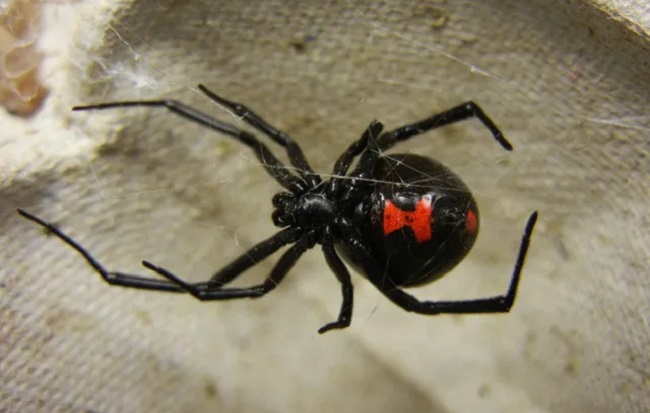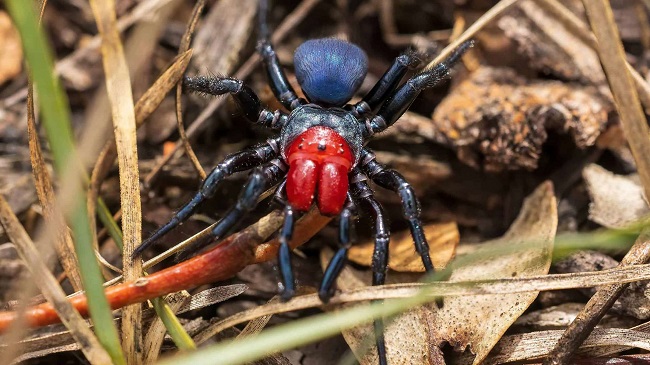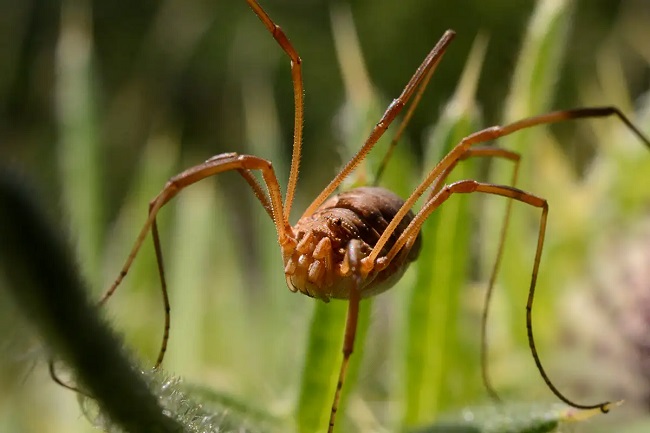Spiders are among the most diverse and widespread creatures on Earth, playing crucial roles in ecosystems by controlling insect populations.
This article explores the top 30 types of spiders in the world, highlighting their unique characteristics, habitats, and ecological importance.
Exploring the World of Spiders: Top 30 Types of Spiders Around the Globe
1. Black Widow Spider (Latrodectus spp.)

Black Widow Spiders are known for their distinctive black bodies and red hourglass markings on the underside of their abdomens. These spiders are found in temperate regions worldwide and are notorious for their potent venom.
While their bites are rarely fatal to humans, they can cause severe pain and other symptoms. Black Widows are beneficial for controlling pest populations.
2. Tarantula (Theraphosidae)
Tarantulas are large, hairy spiders found in tropical and subtropical regions around the world. These spiders are known for their impressive size and variety of colors. Despite their intimidating appearance, tarantulas are generally docile and their venom is not harmful to humans.
Tarantulas are popular as exotic pets and are important for maintaining the balance of insect populations in their habitats.
3. Brazilian Wandering Spider (Phoneutria spp.)
The Brazilian Wandering Spider, also known as the Banana Spider, is one of the most venomous spiders in the world. These spiders are native to South America and are known for their aggressive behavior and potent venom.
They are called “wandering spiders” because they do not build webs but roam the forest floor at night in search of prey.
4. Wolf Spider (Lycosidae)
Wolf Spiders are a large family of ground-dwelling spiders found worldwide. These spiders are known for their excellent hunting abilities, chasing down their prey rather than spinning webs. Wolf Spiders have robust bodies and excellent vision, allowing them to be effective nocturnal hunters. They play a crucial role in controlling insect populations.
5. Jumping Spider (Salticidae)
Jumping Spiders are a diverse group of small, agile spiders known for their excellent vision and jumping abilities. These spiders are found in various habitats worldwide, from tropical forests to urban environments. Jumping Spiders are curious and active hunters, often displaying intricate courtship dances. They are important for controlling pest insects.
6. Huntsman Spider (Sparassidae)
Huntsman Spiders are large, fast-moving spiders found in warm regions around the world. These spiders are known for their crab-like appearance and long legs. Huntsman Spiders do not build webs; instead, they hunt their prey by ambushing or chasing them. Despite their size, they are generally harmless to humans and help control insect populations.
7. Goliath Birdeater (Theraphosa blondi)
The Goliath Birdeater is the largest spider in the world by mass and size, native to the rainforests of South America. These tarantulas have a leg span of up to 11 inches and are known for their impressive size.
Despite their name, they rarely eat birds, preferring insects and small vertebrates. The Goliath Birdeater is an important predator in its ecosystem.
8. Garden Spider (Araneidae)
Garden Spiders, also known as Orb-Weaver Spiders, are found in gardens and forests around the world. These spiders are known for their intricate, wheel-shaped webs. Garden Spiders vary in size and color, often featuring striking patterns. They play a crucial role in controlling insect populations by capturing flying insects in their webs.
9. Brown Recluse Spider (Loxosceles reclusa)
The Brown Recluse Spider is known for its violin-shaped marking on its back and its potent venom. These spiders are native to the United States and prefer dark, secluded areas. Brown Recluse bites can cause significant tissue damage but are rarely fatal. They are important for controlling pest populations, particularly in indoor environments.
10. Peacock Spider (Maratus spp.)
Peacock Spiders are small, colorful jumping spiders native to Australia. These spiders are known for the males’ vibrant, peacock-like display during courtship rituals.
Peacock Spiders are harmless to humans and are fascinating for their intricate behaviors and striking appearance. They play a role in controlling insect populations in their habitats.
11. Daddy Longlegs Spider (Pholcidae)
Daddy Longlegs Spiders, also known as cellar spiders, are found worldwide in dark, damp places like basements and caves. These spiders are known for their long, slender legs and delicate bodies. Despite myths, their venom is not harmful to humans. Daddy Longlegs Spiders help control insect populations, including other spiders.
12. Trapdoor Spider (Ctenizidae)
Trapdoor Spiders are found in warm regions around the world, including North America, Australia, and Africa. These spiders are known for their unique burrows, which have a hinged “trapdoor” made of silk and debris.
They are ambush predators, waiting for prey to pass by before quickly grabbing them. Trapdoor Spiders play a crucial role in controlling soil-dwelling insect populations.
13. Spiny Orb-Weaver Spider (Gasteracantha spp.)
Spiny Orb-Weaver Spiders are found in tropical and subtropical regions worldwide. These spiders are easily recognizable by their brightly colored, spiky abdomens. They build intricate orb-shaped webs and are effective at catching flying insects. Spiny Orb-Weavers contribute to controlling pest populations in their habitats.
14. Mouse Spider (Missulena spp.)

Mouse Spiders are found in Australia and South America. These spiders are known for their robust bodies and powerful jaws. Mouse Spiders dig burrows and are ambush predators, similar to trapdoor spiders. Their venom can be harmful to humans, but bites are rare. They play a role in controlling insect and small vertebrate populations.
15. Golden Silk Orb-Weaver (Nephila spp.)
Golden Silk Orb-Weavers, also known as Banana Spiders, are found in warm regions worldwide. These spiders are known for their large size and the golden color of their silk.
They build large, intricate webs that can capture a variety of insects. Golden Silk Orb-Weavers are important for maintaining insect populations and are fascinating for their impressive web-building abilities.
16. Zebra Spider (Salticus scenicus)
The Zebra Spider, a type of jumping spider, is found in Europe and North America. These small spiders are known for their black and white striped patterns, resembling a zebra. Zebra Spiders are active hunters, using their excellent vision to stalk and jump on their prey. They are important for controlling small insect populations.
17. Six-Eyed Sand Spider (Sicarius hahni)
The Six-Eyed Sand Spider is native to the deserts of southern Africa. These spiders are known for their flattened bodies and ability to bury themselves in the sand to ambush prey. They have potent venom, but bites to humans are extremely rare. Six-Eyed Sand Spiders play a crucial role in controlling insect populations in arid environments.
18. Crab Spider (Thomisidae)
Crab Spiders are found worldwide and are known for their crab-like appearance and ability to walk sideways. These spiders do not build webs but are ambush predators, often found on flowers where they catch visiting insects. Crab Spiders are important for controlling pollinator populations and maintaining ecological balance.
19. Funnel-Web Spider (Atracidae)
Funnel-Web Spiders are native to Australia and are known for their funnel-shaped webs. These spiders are highly venomous, and some species, like the Sydney Funnel-Web, can be dangerous to humans. Despite their venom, they play a vital role in controlling insect populations and maintaining soil health through their burrowing activities.
20. Hobo Spider (Eratigena agrestis)
The Hobo Spider is found in Europe and North America, often in urban areas. These spiders are known for their funnel-shaped webs and rapid movements. Hobo Spiders are ground-dwellers and are often found in basements and garden areas.
They help control insect populations but have a reputation for their bites, which can cause localized reactions.
21. Peacock Jumping Spider (Maratus spp.)
Peacock Jumping Spiders are native to Australia and are renowned for their vibrant colors and intricate courtship displays. The males have colorful, peacock-like abdominal flaps that they raise and wave to attract females. These small spiders are harmless to humans and play a crucial role in controlling insect populations.
22. Bolas Spider (Mastophora spp.)
Bolas Spiders are found in the Americas and are known for their unique hunting method. These spiders produce a sticky, ball-like silk structure (bolas) that they swing to capture moths attracted to their pheromones. Bolas Spiders contribute to controlling moth populations and are fascinating for their specialized hunting techniques.
23. Orb-Weaver Spider (Araneus spp.)
Orb-Weaver Spiders are found worldwide and are known for their beautifully constructed, wheel-shaped webs. These spiders come in various colors and sizes, often with striking patterns. They play an essential role in controlling flying insect populations, including mosquitoes and flies, by capturing them in their intricate webs.
24. Fishing Spider (Dolomedes spp.)
Fishing Spiders are found near bodies of water in North America and Europe. These large spiders can walk on water and even dive to catch prey such as fish and aquatic insects. Fishing Spiders are beneficial for controlling aquatic insect populations and are known for their impressive hunting skills.
25. Sydney Funnel-Web Spider (Atrax robustus)
The Sydney Funnel-Web Spider, native to Australia, is one of the most venomous spiders in the world. These spiders are known for their aggressive behavior and potent venom. Despite their danger to humans, they play a critical role in controlling insect populations and maintaining soil health through their burrowing activities.
26. Lynx Spider (Oxyopidae)
Lynx Spiders are found worldwide and are known for their agility and excellent vision. These spiders are active hunters, often found on plants where they hunt for insects. Lynx Spiders are recognized by their spiny legs and usually bright colors. They contribute to controlling pest insect populations in gardens and agricultural fields.
27. Ant-Mimicking Spider (Myrmarachne spp.)
Ant-Mimicking Spiders are found in tropical and subtropical regions. These spiders have evolved to closely resemble ants in appearance and behavior, which helps them avoid predators and hunt ants more effectively. Ant-Mimicking Spiders play a role in controlling ant populations and are fascinating examples of mimicry in nature.
28. Green Lynx Spider (Peucetia viridans)
The Green Lynx Spider is native to the Americas and is known for its bright green color and spiny legs. These spiders are often found on plants and flowers, where they hunt for insects. Green Lynx Spiders are important for controlling pest populations in gardens and agricultural fields.
29. Wasp Spider (Argiope bruennichi)
The Wasp Spider, found in Europe and Asia, is known for its striking black and yellow markings, resembling a wasp. These spiders build large orb webs and are effective at catching flying insects. Wasp Spiders contribute to controlling insect populations and are known for their impressive web-building skills.
30. Harvestman Spider (Opiliones)

Harvestman Spiders, also known as Daddy Longlegs, are found worldwide and are known for their long, slender legs and small, rounded bodies. Unlike true spiders, they have a fused body segment.
Harvestman Spiders are scavengers and predators, feeding on small insects and decomposing organic matter. They play a role in nutrient cycling and pest control.
Conclusion
These top 30 types of spiders highlight the incredible diversity and ecological importance of these arachnids. From the venomous Brazilian Wandering Spider to the colorful Peacock Spider, each species plays a unique role in its ecosystem.
Understanding and appreciating these spiders can help us recognize their value in maintaining ecological balance and controlling pest populations. By respecting and protecting their habitats, we can ensure that these remarkable creatures continue to thrive in the wild.



